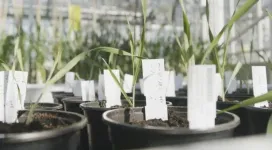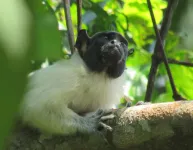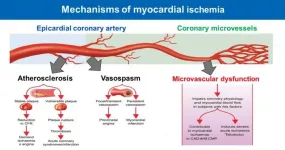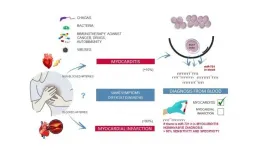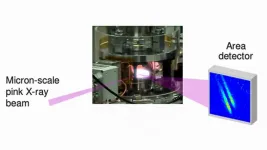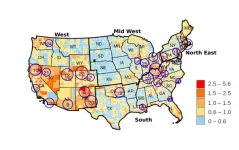INFORMATION:
Creation and judicious application of a wheat resistance gene atlas. Appears in: Molecular Plant. https://www.sciencedirect.com/science/article/pii/S1674205221001751?via%3Dihub
Scientists call for international investment to tackle major wheat losses
2021-05-27
(Press-News.org) Urgent investment in new tools is needed to address major global losses of wheat crops which cost £22 billion per year.
Leading scientific experts are calling for governments around the world to come together and fund a new international research platform, to reduce the impact of major wheat pathogens and improve global food security.
The John Innes Centre is calling for an internationally coordinated approach to deliver a new 'R-Gene Atlas', which would help identify new genetic solutions conferring disease resistance for crops, which could be bred into commercial wheat varieties.
Globally, we lose one fifth of the projected wheat yield annually to pests and pathogens totaling losses of 209 million tonnes, worth £22 billion ($31 billion). The climate emergency has the capacity to bring further disruption to global food supplies, as a changing environment brings new types of pests and diseases and increases their spread.
To minimise these losses, and to reduce reliance on chemical solutions, the team calls for broader use of disease resistance to be found in the genome of wheat and its wild relatives. The aim is to provide long-lasting molecular protection against wheat's major pathogens including wheat rusts, blotch diseases, powdery mildew, and wheat blast.
In 2016 global trade saw the wheat blast fungus, typically isolated to South America, arrive in Bangladesh, where it destroyed 15,000 hectares of wheat, resulting in yield losses of 25-30% and threatening wheat production across South Asia.
Wheat R genes work by recognising corresponding molecules in the pathogen called effectors. By identifying the effectors present in pathogen and pest populations, more durable combinations or "stacks" of R genes could be designed.
The R-gene atlas will be a free online portal containing this genetic information and enabling breeders to design gene stacks using computer modelling before starting their breeding in the field.
It will enable users to design molecular markers that could be used to find out what resistance genes they already have in their breeding programme or wheat populations.
The idea builds upon the recent surge in genomic resources available to researchers in wheat, facilitated by advancements in sequencing technologies and bioinformatics. In the past few years, researchers at the John Innes Centre and The Sainsbury Laboratory have rapidly identified and cloned resistance genes in wheat and its wild relatives using technologies such as AgRenSeq, MutRenSeq and MutChromSeq.
The new proposal details how the molecular components involved in disease resistance - R genes and effectors - could be captured from both the host and pathogen. Whole genome sequencing would be carried out on diversity panels of wheat, its progenitors and domesticated and wild relatives.
Association genetics, a method of seeking useful genetic variation, could then be used to look for correlations between the host genotype and disease resistance or susceptibility and the genes responsible for these traits could be identified. The researchers calculate it would cost around £41 million ($58.6 million) to establish the new platform at the required scale. Costed, detailed proposals for the R-Gene Atlas are set out in a new article in Molecular Plant.
This would include sequencing diversity panels of the pathogens and 10 host species of wheat, as well as funding 75 scientists across the world to carry out the work.
This, they suggest, could be funded by contributions of £2 million ($2.9 million) per G20 country spread over five years - a minor investment considering the current financial losses across the world to wheat diseases. This extensively collaborative funding model would spread the risk on a project which would have global reward.
"Compared to the scale of the problem in yield losses to pests and pathogens, this represents excellent value for money" says first author Amber Hafeez. "It is unsustainable to continue feeding 20 per cent of our wheat production to pathogens. Our enterprise applies cutting edge science to a global challenge that is increasing due to the climate emergency."
The proposal involves bringing together an international consortium to allow the project to draw upon existing expertise and resources.
"A lot of the pieces of the puzzle already exist, the idea is to bring them together to make sure we don't duplicate efforts," says Dr Brande Wulff, corresponding author of the article. "We see it as a centrally coordinated model distributed around different countries, using existing capacity.
"Current projections suggest there will be 2.1 billion more people to feed by 2050 and developing disease-resistant crops will be a key part of sustainably feeding us all. We're determined to develop new ways to increase our genetic understanding and deploy it for the benefit of sustainable agriculture, but we cannot do this without investment."
"We are urging the G20 governments to invest in the consortium, which will bring disease resistance genes from lab to field at a scale and speed needed to deal with the current crisis."
The idea has been trialed earlier this year and has drawn an enthusiastic response from the international wheat research community. Amber Hafeez said : "We have been delighted with the initial enthusiastic response to our proposals - many research groups and collaborators have welcomed the idea and we feel this confirms our belief that the time is right for this proposal."
ELSE PRESS RELEASES FROM THIS DATE:
Global study finds each city has unique microbiome fingerprint of bacteria
2021-05-27
Each city has its own unique microbiome, a "fingerprint" of viruses and bacteria that uniquely identify it, according to a new study from an international consortium of researchers that included a team from the University of Maryland School of Medicine (UMSOM). The international project, which sequenced and analyzed samples collected from public transit systems and hospitals in 60 cities around the world, was published today in the journal Cell.
The research is considered to be the largest-ever global metagenomic study of urban microbiomes, spanning both the air and the surfaces of multiple cities. It features a comprehensive ...
Primates change their 'accent' to avoid conflict
2021-05-27
New research has discovered that monkeys will use the "accent" of another species when they enter its territory to help them better understand one another and potentially avoid conflict.
Published in the journal Behavioral Ecology and Sociobiology, the study is the first to show asymmetric call convergence in primates, meaning that one species chooses to adopt another species' call patterns to communicate.
The study, co-authored by Dr Jacob Dunn of Anglia Ruskin University (ARU), investigated the behaviour of 15 groups of pied tamarins (Saguinus bicolor) and red-handed tamarins (Saguinus midas) in the Brazilian Amazon.
Pied tamarins are critically endangered and have one of the smallest ...
Disease of the smallest heart blood vessels is important global health problem
2021-05-27
For the first time, a prospective, international study has shown that chest pain caused by problems with the very small vessels supplying blood to the heart is an important health problem that increases the risk of heart attacks, stroke and death due to cardiovascular reasons.
The study, which is published today (Thursday) in the European Heart Journal [1], recruited 686 patients from 14 institutions in seven countries on four continents [2] between July 2015 and December 2018 to investigate microvascular angina (MVA). Until now, MVA was widely thought to be a benign disease that mainly occurs in women. However, the ...
Better peatland management could cut half a billion tons of carbon
2021-05-27
Half a billion tonnes of carbon emissions could be cut from Earth's atmosphere by improved management of peatlands, according to research partly undertaken at the University of Leicester.
A team of scientists, led by the UK Centre for Ecology and Hydrology (UKCEH), estimated the potential reduction of around 500 million tonnes in greenhouse gas (GHG) emissions by restoring all global agricultural peatlands.
Peatlands - a type of wetland, where dead vegetation is stopped from fully breaking down - cover just 3% of the global land surface, but store around 650 billion tonnes of ...
Lower rates of kidney transplant referrals at for- vs. non-profit dialysis facilities
2021-05-27
Highlights
Among patients receiving dialysis in the Southeastern United States, those at for-profit dialysis facilities were less likely to be referred for kidney transplantation than those at non-profit facilities.
Rates of starting medical evaluations soon after referral and placing patients on a waitlist after evaluations were similar between the groups.
Washington, DC (May 26, 2021) -- New research indicates that patients with kidney failure who receive care at for-profit dialysis facilities are less likely to be referred for kidney transplants that those receiving care at non-profit ...
The first blood biomarker to distinguish between myocarditis and acute myocardial infarction
2021-05-27
Scientists at the Centro Nacional de Investigaciones Cardiovasculares (CNIC) have identified the first blood biomarker for myocarditis, a cardiac disease that is often misdiagnosed as myocardial infarction. Nevertheless, the diagnosis of myocarditis continues to be challenging in clinical practice.
The study, led by Dr. Pilar Martín and published today in The New England Journal of Medicine, has detected the presence of the human homolog of micro RNA miR-721 in the blood of myocarditis patients.
CNIC General Director Dr. Valentín Fuster emphasizes that these results of paramount importance because they establish the first validated blood marker with high sensitivity and specifity (>90%) for myocarditis. This will allow ...
Immediate skin-to-skin contact after birth improves survival of pre-term babies
2021-05-27
Continuous skin-to-skin contact starting immediately after delivery even before the baby has been stabilised can reduce mortality by 25 per cent in infants with a very low birth weight. This according to a study in low- and middle-income countries coordinated by the WHO on the initiative of researchers at Karolinska Institutet published in The New England Journal of Medicine.
Continuous skin-to-skin contact between infant and mother, or "Kangaroo Mother Care" (KMC), is one of the most effective ways to prevent infant mortality globally. The current recommendation from the World Health Organization (WHO) is that skin-to-skin contact should commence ...
People prefer 'natural' strategies to reduce atmospheric carbon
2021-05-26
ITHACA, N.Y. - Soil carbon storage, carbon capture and storage, biochar - mention these terms to most people, and a blank stare might be the response.
But frame these climate change mitigation strategies as being clean and green approaches to reversing the dangerous warming of our planet, and people might be more inclined to at least listen - and even to back these efforts.
A cross-disciplinary collaboration led by Jonathon Schuldt, associate professor of communication at Cornell University, found that a majority of the U.S. public is supportive of soil carbon storage as a climate change mitigation strategy, particularly when that and similar approaches are seen as "natural" strategies.
"To me, that psychology part - that's really interesting," Schuldt ...
Unveiling what governs crystal growth
2021-05-26
With brilliant colors and picturesque shapes, many crystals are wonders of nature. Some crystals are also wonders of science, with transformative applications in electronics and optics. Understanding how best to grow such crystals is key to further advances.
Scientists from the U.S. Department of Energy's (DOE) Argonne National Laboratory, along with three universities, have revealed new insights into the mechanism behind how gallium nitride crystals grow at the atomic scale.
Gallium nitride crystals are already in wide use in light-emitting diodes, better known as LEDs. They might also be applied to form transistors for high-power switching electronics to make electric grids more energy efficient and smarter. The use of such "smart grids," which ...
Opiate overdoses linked to poor mental health
2021-05-26
The opioid epidemic is taking a deadly toll on people in disproportionate clusters from Cape Cod to San Diego, according to a new study by the University of Cincinnati.
Fatal opiate overdoses are most prevalent among six states: Ohio, Pennsylvania, Kentucky, West Virginia, Indiana and Tennessee. But researchers identified 25 hot spots of fatal opioid overdoses nationwide using data from the Centers for Disease Control and Prevention.
The study demonstrates how both widespread and localized the problem of substance use disorders can be, UC assistant professor and co-author Diego Cuadros ...
